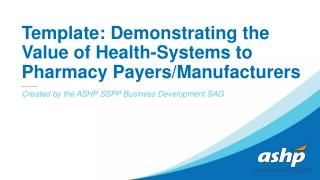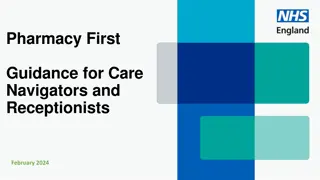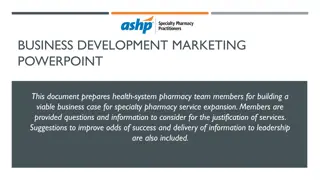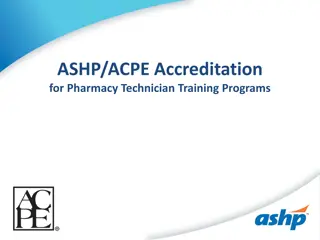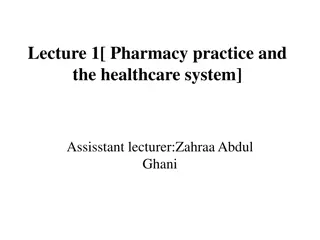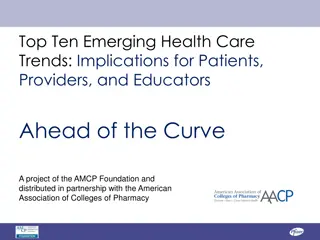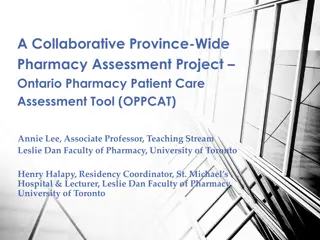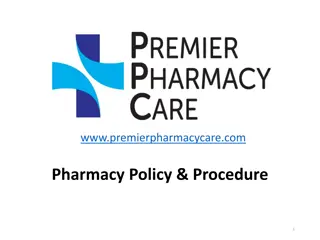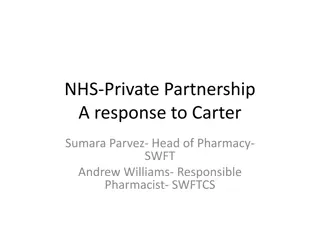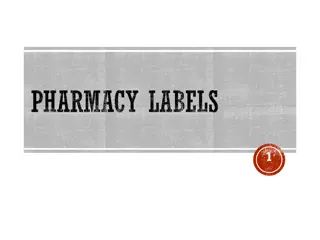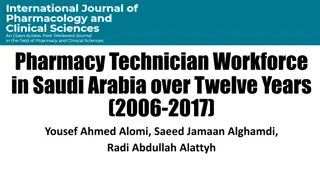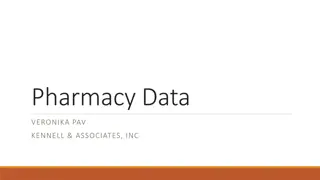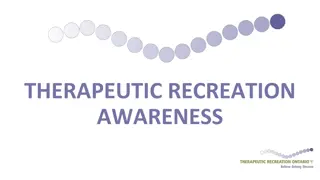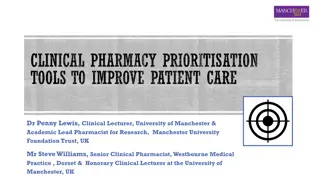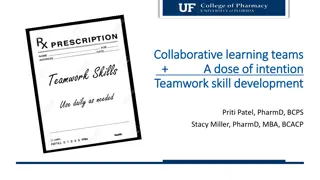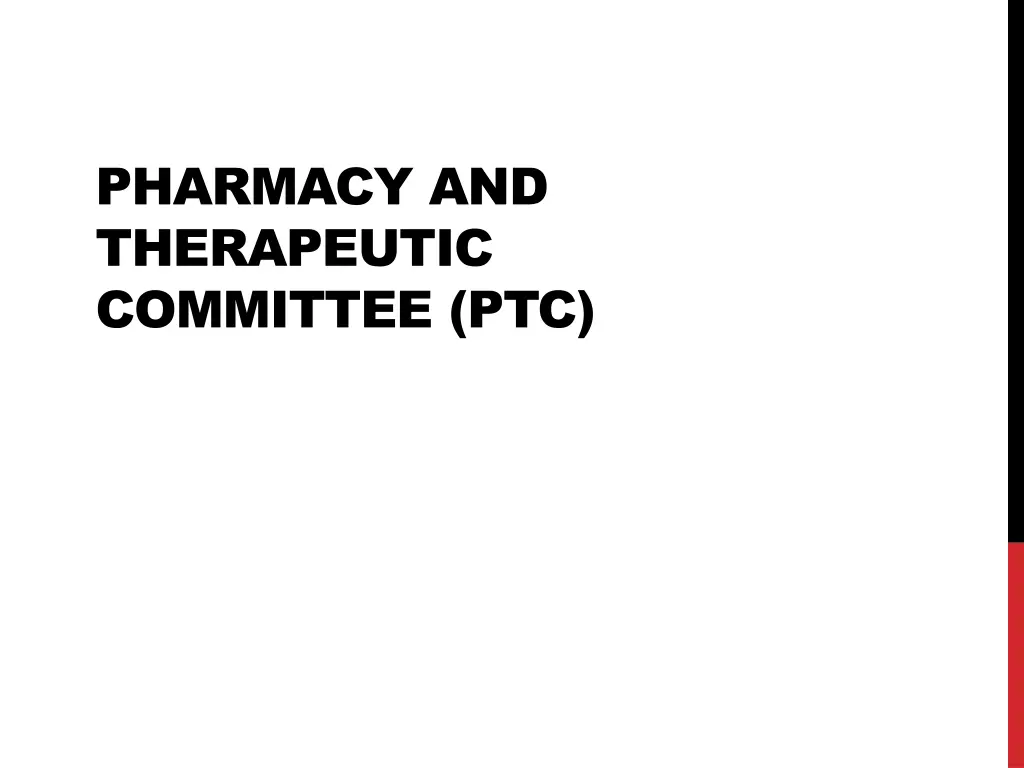
Understanding the Role of Pharmacy and Therapeutic Committee (PTC)
Learn about the definition, role, responsibilities, organization, and operation of the Pharmacy and Therapeutic Committee (PTC) in hospitals. The PTC serves as an advisory group that ensures the safe and effective use of medication for patients through policy recommendations and educational initiatives.
Uploaded on | 2 Views
Download Presentation

Please find below an Image/Link to download the presentation.
The content on the website is provided AS IS for your information and personal use only. It may not be sold, licensed, or shared on other websites without obtaining consent from the author. If you encounter any issues during the download, it is possible that the publisher has removed the file from their server.
You are allowed to download the files provided on this website for personal or commercial use, subject to the condition that they are used lawfully. All files are the property of their respective owners.
The content on the website is provided AS IS for your information and personal use only. It may not be sold, licensed, or shared on other websites without obtaining consent from the author.
E N D
Presentation Transcript
PHARMACY AND THERAPEUTIC COMMITTEE (PTC)
DEFINITION DEFINITION The pharmacy and therapeutics committee(PTC) is an advisory group of the medical staff and serves as the organizational line of communication between the medical staff and the pharmacy department. The committee is composed of physicians, the pharmacist and the other health professionals selected with guidance of the medical staff. It is the policy recommendation body to the medical staff and administration of the hospital on matter related to the therapeutic use of drugs. This committee assists in the formulation of broad professional policies regarding the evaluation, distribution, use, safety procedures and other matters relating to drugs use in the hospital. selection, procurement,
ROLE OF PTC The pharmacy and therapeutic committee has a dual role to play: 1.Advisosory: The committee assists in the formulation of professional polices regarding evaluation, selection and therapeutic use of drugs in hospital. 2.Educational: The committee recommends and assists in various functions, designed to meet the needs of the professional staff, the physicians, nurses , pharmacist and other health care professional for the complete current knowledge of the matters pertaining to drugs.
RESPONSIBILITY RESPONSIBILITY Ensure safety medication to patients The preparations of a hospital formulary, Publishing of a pharmacy educational bulletin, The establishment of automatic stop orders for dangerous drugs, The supervision of investigational use drugs, The development of a program for reporting and investigating adverse drug reactions and Assisting in the preparation of emergency kits or carts for medical emergencies.
ORGANIZATION AND ORGANIZATION AND OPERATION OPERATION The organizational composition and operation of the pharmacy and therapeutics committee might vary from hospital to hospital, the followings are generally applied: The pharmacy and therapeutics committee should be composed of at least three physicians, a pharmacist, a nurse and an administrator. Committee members are appointed by governing unit or elected official of the organized medical staff. A chairman from among the physician representatives should be appointed. A pharmacist usually is designed as secretary. The committee should meet regularly, at least six times a year and more often when necessary.
The committee should invite to its meeting persons within or outside the hospital who can contribute specialized or unique knowledge, skills, and judgments. An agenda and supplementary materials (including minutes of the previous meeting) should be prepared by the secretary and submitted to the committee members in sufficient time before the meeting for them to properly review the material. Minutes of the committee of the committee meetings should be prepared by the secretary and maintained in the permanent records of the hospital. Recommendations of the committee shall be presented to the medical staff or its appropriate recommendation. Liaison with other hospital committee with drug use shall be maintained. committee for adoption or
PURPOSE OF THE COMMITTEE PURPOSE OF THE COMMITTEE The pharmacy and therapeutics organizational line of liaison between the medical staff and the pharmacy service on all matters pertaining to the use of drugs in the hospital. Its prime objective is to achieve optimal patient care and safely through rational drug therapy. committee serves as the The committee s task should be clearly defined Members should be selected from among those who have some definite relationship to the tasks to be accomplished. For optimal effectiveness, superiors and subordinates should not serve on the same committee. Committee must have time to evolve interpersonal relationships before they can move on to effective problem solving. To function most effectively, committee require the support of the groups of individuals to whom the results of their deliberation are to be submitted. Committee s major role is to communicate events and to develop the managerial competence of members.
COMMITTEE AGENDA COMMITTEE AGENDA A successful meeting depends upon the preparation of an interesting agenda which is made available to the committee members reasonably far in advance of the scheduled meting. Many interesting subjects may, rightfully, be placed upon the agenda for discussion and proper suggestions by the committee. A typical agenda may consist of the following general categories: 1) Minutes of the previous meeting. 2) Review of a specified of the Formulary for up-dating and deletion of products. 3) New drugs which have become commercially available. 4) Investigational use of drugs currently in use in the hospital. 5) Review of adverse drug reactions reported in the hospital since the last meeting. 6) Drug safety in the hospital. 7) Slow moving medication.
FUNCTION OF COMMITTEE FUNCTION OF COMMITTEE Committee having as diversified a membership as the pharmacy and therapeutics committee need to have a set of guidelines which delineate it activity. A. To serve in an advisory capacity to the Medical Staff, to hospital administration and to the Pharmacy Department on all matters pertaining to the use of drugs in the hospital. Actions taken by the committee are subject to review and approval by the Executive Committee of the Medical Staff. B. To assist the Pharmacy Department in the development and review of policies, rules and regulations regarding the use of drugs in the hospital in accordance with local, state and federal regulatory and accreditation agencies . C . To evaluate approve or reject drugs proposed for inclusion in or deletion from the Hospital Formulary .
D . To define categories of drugs used in the hospital and assign each drug to a specified categories . E . To review drug utilization in the hospital and promote optimum standards for rational drug therapy . F . To collect and review adverse drug reaction reports . G . To develop and disseminate pertinent educational materials and programs regarding to the members of the Medical and Nursing staffs .
COMMITTEES ROLE COMMITTEE S ROLE IN DRUG SAFETY IN DRUG SAFETY With advent of each new class of therapeutic agents, the scope, knowledge and responsibility pharmacist increases commensurately . Hand-in-hand with this increased responsibility goes the moral, legal, and professional obligation of insuring safely in the handing and administration of drugs . of the hospital So the function and responsibility of the pharmacy and Therapeutics Committee and should be an on-going program.
COMMITTEES ROLE IN DRUG COMMITTEE S ROLE IN DRUG SAFETY SAFETY The following may be serve as a guide to this Committee in ascertaining the safeness of the hospital pharmacy. 1. Does the hospital employ a qualified registered pharmacist to supervise the pharmacy ? 2. Does the hospital permit non-pharmacist personnel to dispense drugs and allied materials ? 3. Does the hospital employ a sufficient number of qualified personnel to allow for adequate coverage of pharmacy seven days per week or 24 hr of the day ? 4. Does the hospital provide adequate, safe work space, and safe storage facilities for the pharmacy ? 5. Does the hospital have an adequate stop order regulation for dangerous drugs such as narcotics, hypnotics and anticoagulants ?
6. Does the hospital have a drug formulary ? If so , is it periodically revised and kept up-to-date? 7. Are internal use preparations adequately separated from non- internal use medications ? 8. Are all nursing stations periodically inspected for the purpose of removing deteriorated and outdated drugs as well as to check all labels for legibility? 9. Does the pharmacy have an adequate reference library which contains texts on pharmacology, toxicology and physiology?
COMMITTEES ROLE IN THE COMMITTEE S ROLE IN THE ADVERSE DRUG REACTION ADVERSE DRUG REACTION PROGRAM PROGRAM Adverse drug reaction may be define as- An adverse drug reaction includes any pathological condition precipitated by a drug regardless of its nature or the circumstances of its occurrence, i.e. toxicity caused by overdose ,hypersensitivity , allergy, or injury from improper technique of administration, use of the wrong drug , error in compounding, labeling or packaging or from other error in the manufacture of the drug or its preparation for use in the hospital. A consequence of recent advances in drug therapy is the proportionate increase in drug reactions. In order to gain an understanding of these problems and to formulate competent options as the best type of prevention and treatment, the PTC must assume the responsibility for developing and instituting a procedure for the prompt reporting of an adverse drug reaction. Reaction caused by blood and plasma products need to be reported unless a chemical agent other than the basic substance is responsible. An adverse Drug Reaction(ADR) Report From, should be prepared by the PTC and made available on every nursing station.
Name of the hospital Adverse Drug Reaction Report 1. Drug or agent involved: . 2. Type of Reaction: .. 3. Therapy and Result: ... 4. Age 5. Sex (M/F) 6. Source of Drug -Prescription -Over the counter drug -Others Attending Physician
Every case of adverse drug reaction must be reported by the attending doctor to the clinical pharmacologist, if one is available, otherwise to the chairman of PTC. The completed ADR from of any having adverse drug reaction, will remove from the medical record and forward to the chairman or clinical pharmacologist, after discharge of the patient.
DRUG PRODUCT DEFECT REPORTING DRUG PRODUCT DEFECT REPORTING PROGRAM PROGRAM THE ASHSP, THE USP AND FDA INITIATED A DRUG PRODUCT DEFECT REPORTING PROGRAM ASHSP MEMBER, COMMUNITY PHARMACISTS, NURSES AND HOSPITAL PHARMACISTS WHO ARE NOT MEMBERS OF THE ASHSP. Hospital Pharmacist s Drug Defect Report 1. Trade name, Dosage form, Strength: . 2. Lot number: . 3. Date Purchased: . 4. Source of the Drug: . 5. Name and Address of the Drug Manufacturer: 6. Reporting Pharmacist s Name: . 7. Name and Address of the hospital: 8. Defect noted and Suspected: .. Returned to Legislative authority of the respective country
Reportable defects include inadequate packing, confusing or inadequate labels or labeling, deteriorated, contaminated or defective dosage forms, inaccurate fill or count of a drug product, faculty drug delivering apparatus etc. obviously the participant should report anything which, in their professional opinion, is considered to be defective or undesirably associated with the product.
AUTOMATIC STOP ORDER FOR DANGEROUS DRUGS The PTC should develop a means whereby dangerous drug may be properly administered under responsible medical staff and control a automatic stop process in force in the hospital. All drugs orders for narcotics, sedatives, hypnotics and anticoagulants, shall be automatically discontinued after 72 hours or 48 hours, antibiotics (oral and parenteral) shall be discontinued after 7 days and other prescription drugs are after 14 days, unless (1) the order indicates an exact number of doges to be administered, (2) an exact period of time for the medication in specified or (3) the attending physician records the medication. specially for in- patients.

